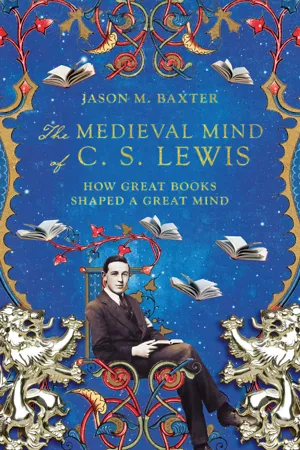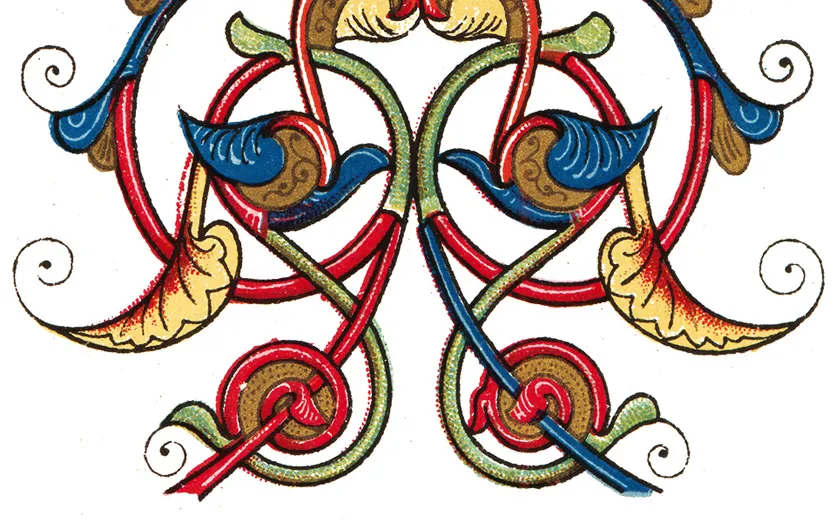IN THE POPULAR IMAGINATION, as Lewis joked more than once, the term “Middle Ages” evokes a misty blend of knights, castles, witch trials, torture devices, armor, superstitious peasants (covered in dirt), and maybe a dragon and princess thrown in to boot. Need it be said? That was not how Lewis envisioned the time period. Rather, as he pointed out in all of his academic writing, the medieval period was not an age of primitive superstition, but one of bookish sophistication (see epigraph), and anyone who has wandered around a great, Old World cathedral, like Salisbury Cathedral, has some idea of what Lewis’s comparison means: it is a paradoxical juxtaposition of astonishing variety, meticulous order, and a saturation of light. On the one hand, both modern and medieval visitors are dazed by the height of the vault, the forest of ordered columns, the infinite variety of decorative motifs and side chapels and stones, while being impressed, at the same time, by the radiation of color, as if light were dwelling in living stones. In a phrase, this is what Lewis meant by “finely ordered multiplicity.”1 But in addition to these structures of literary, logical, and architectural order—the Comedy, Summa, and Salisbury Cathedral—Lewis wanted to include one more work of art as “typical” of the medieval achievement: the “medieval synthesis itself, the whole organisation of their theology, science, and history into a single, complex, harmonious mental Model of the Universe.”2 In other words, what Lewis admired most was not simply this or that medieval belief or doctrine, but rather the whole way of viewing the world, the whole ensemble, the whole intellectual “atmosphere” of what I have called the Long Middle Ages, and it was that which he, as the modern Boethius, felt it was vital to preserve, explain, and make intelligible, even within modernity. In short, Lewis perceived that for the medieval period, the natural world, like so many stained-glass windows, was, as it were, transparent to a light from beyond this world. What are for us merely natural processes seemed to our ancestors phenomena that pointed beyond themselves. The whole world felt like a cosmic cathedral.
This chapter will build on the previous one by explaining what it was exactly that Lewis saw and felt in the medieval period that justified the intensity of his lifelong devotion to the study and “translation” of ideas and texts from the medieval period into the modern vernacular. And what we’ll see is that this ensemble of beliefs that made up the medieval “model”—Lewis’s term for the cosmic imaginary of the medieval period—was not only a kind of work of art, but, more importantly, an image, a powerful thought experiment, a kind of icon.
It was this medieval view of the universe that became the root metaphor for his “doctrine” of transposition. In one of his greatest sermons, Lewis develops a musical metaphor, “transposition,” to refer to those various moments when a higher, more complicated system is expressed in a lower, less complicated one—for example, when a Mahler symphony, with its gargantuan orchestration for four hundred instruments, is transposed for a piano, or when a language with a huge vocabulary is translated into one with a limited one (like Latin into Anglo-Saxon). This happens, too, in our emotional lives. In the sermon, Lewis reflects on a passage from Samuel Pepys’s diary, in which the seventeenth-century author, in an effort to describe the delight and rapture he experienced at a concert, compared that aesthetic experience to the jittery nerves he had suffered when he first fell in love with his wife, as well as to the jittery nerves he experienced when seasick! The bodily experience of falling in love, the fluttering of the diaphragm that we experience when in love, the rapturous shortness of breath we experience when we listen to Elgar’s Cello Concerto, or the queasy fluttering of the diaphragm we suffer when we are sick at sea are all, on the mere physiological level, impossible to distinguish.3 But if we believe that the emotional life is higher, more varied, and more subtle than the life of bodily needs and sensations, it follows that we encounter the bodily language’s “limited vocabulary” when the life of the mind and heart overflow into our physical sensations.4 Lewis develops this thought experiment of transposition in order to construct an explanatory model for how higher spiritual realities are related to lower sensible realities. As my emotions are to my physical sensations, so too is the “higher world” to the natural world of time and nature: it fills this world and makes it seem “too full,” “too dense” to not point beyond itself.
This, then, is what is at stake when considering Lewis’s admiration for medieval cosmology, because for him the medieval universe was not just a system of exploded scientific beliefs, but the natural, icon of transposition, the greatest example of the spiritual world expressing itself in the limited vocabulary of the physical, natural world. And what nuclear reactors, particle accelerators, and the Hubble telescope are for us, the medieval cathedral—and the cosmological “model” it represented—was for the medieval period: a kind of “experiment” that made visible an elusive and deeper truth. It is this iconic vision of the medieval cosmos that Lewis tried to get his students and audiences to see, and feel, and breathe. Thus the Oxford professor’s interest in medieval cosmology was not merely an arcane, archaeological antiquarianism. Why? Because being able to see the world with medieval eyes could provide even modern people with a “model” for thinking about the relationship between the natural and spiritual world.
I’ll now try to provide a sketch of what that medieval vision was by drawing from Lewis’s favorite medieval authorities.
A SNAPSHOT OF THE MEDIEVAL COSMOS
Today, if we read the ancient statesman and author Cicero at all, it is because we think of him as a great exemplar of ancient republican politics, as the orator who defended the republic from tyranny by means of the elegant word. In the Middle Ages, though, Cicero’s fame was due to a short, visionary treatise, the “Dream of Scipio,” a ten-page account of a Roman general’s prophetic dream that served as the concluding chapter to his own attempt to respond to Plato in his own Latin-speaking Republic. In the medieval period, the pages that make up this visionary dream tale were copied out independently from the rest of the text, in part because a writer, several centuries later in late antiquity, Macrobius—whose writing is analyzed by Lewis in Discarded Image5—had made it famous by devoting a three hundred-page commentary to it. Macrobius, a Latin-writing Platonist, was working sometime in the early 400s AD, and he was convinced that every word in Cicero’s visionary account had a deep, mystical significance. This belief conditioned the next thousand years to read Cicero’s “Dream of Scipio” in hushed, reverent tones, as if, within these pages, the deep mysteries of the universe were revealed to those with eyes to see. Lewis knew these texts intimately.
In Cicero’s imaginative account Scipio floats up through the spheres of the heavens and comes to stand at the apex of the universe in order to take in a “view from above.” Once there, Scipio (like Dante over a millennium later) is warmly greeted by his male ancestors, who give him lessons in the Roman virtues of honor, justice, and duty. They also make him turn around to contemplate the universe stretched out beneath his feet. At one particularly dramatic moment, Scipio looks down and sees the cosmos moving beneath his feet, and then, hearing an incredible music, he asks, “What is this sound, so loud and yet so sweet, that fills my ears?” His guide answers,
That is the sound produced by the impetus and momentum of the spheres themselves. It is made up of intervals which, though unequal, are determined systematically by fixed proportions. The blend of high and low notes produces an even flow of various harmonies. . . . By imitating this system with strings and voices experts have succeeded in opening a way back to this place. . . . Filled with this sound, people’s ears have become deaf to it.6
In other words, the planets are spaced out proportionally to one another, so that the distances between Earth and Mars, and Venus and Jupiter, correspond to harmonic intervals of chords. As the planets rotate, they create a kind of intellectual music, to which we earthlings have become deaf, but we can regain the ability to hear this music through study or through beautiful music, which imitates the same harmonic proportions.
This idea of a musical universe—whose planets are spaced out like strings on a musical instrument—delighted the imaginations of medieval thinkers. Boethius, to take one example, borrowed this idea from Cicero. In a particularly beautiful poem in his Consolation of Philosophy, Boethius, too, imagines himself high above our universe, viewing the cosmos stretched out beneath his feet. You can hear the author’s excitement and delight as he describes the choreographed movements of the universe:
Starmaker, master of spheres,
At whose command the heavens spin
In the constellations’ dance that you
On your steady throne have choreographed,
Bright stars grow dim as you bring on the moon,
Crescent or gibbous, reflecting her brother’s
Dazzling fire. . . .
When leaves fall and the cold of winter
Blows from the north, our days diminish,
But then, in summer’s burgeoning heat
The dark hours of nighttime dwindle. . . .
Not even the blowing winds are random,
But Boreas strips leaves from the trees
And Zephyrus brings on gentling nurture.7
“Not even the blowing winds are random,” says Boethius rhapsodically. In other words, Boethius closed his eyes, looked at the earth in his mind’s eye, watched its seasons springing up and falling away, and perceived the heavens rotating, all in ordered rhythms. This is what Boethius, in his lesser-known work De musica, called “the music of the cosmos.” For Boethius, as for Cicero, there is a rational order that keeps the world in balance, keeping it from spinning out of control. It ensures that elements of different kinds bond properly to one another; it regulates how the seasons cycle in an ongoing carousel; this order also regulates how the stars and planets turn. He calls this cosmic order “music” because it is a deep, mathematical harmony that frames out the world in understandable patterns. What is more, Boethius (again like Cicero) taught that through instrumental music we can regain a “taste” of the musicality of the world, and thus retune our souls to cosmic music. Music is philosophical therapy, bringing the soul back into tune with the great Conductor’s universe. This is why the Consolation of Philosophy alternates between prose and verse.8
In a 1956 lecture to the Zoological Laboratory in Cambridge, we find ...

